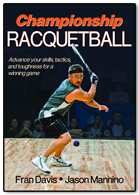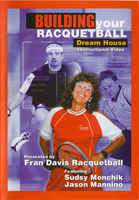 Controlling the match means playing more methodically while aware of what’s happening around you on the court. You don’t rush or hit aimlessly. Every shot you take and every move you make on the court has purpose or an objective. This is a strategy that clearly elevates your level of play. Here are a few tips for controlling the game:
Controlling the match means playing more methodically while aware of what’s happening around you on the court. You don’t rush or hit aimlessly. Every shot you take and every move you make on the court has purpose or an objective. This is a strategy that clearly elevates your level of play. Here are a few tips for controlling the game:
Know the rules— When you really start understanding the rules, you gain the powerful position of using them to your advantage, (correctly) challenging calls that your opponent or the referee makes.
Use Time-Outs Effectively to:
– Recover from a long rally
– Change the momentum of the match
– Regroup and review your game plan if you lose your concentration
– Set your opponent’s rhythm and tempo off
– Get rid of negative thoughts
You should never have a time-out remaining after a game, especially if you lost, because then you haven’t done everything in your power to win.
Manage Game Tempo —The timing, or pace, of the game is referred to as the tempo and rhythm. Unfortunately, most players rush putting the ball into play without thinking about the tempo and rhythm that allows them to play at their best while also disrupting their opponents’ games in order to force them to play poorly. Try lob serves or ceiling shots against a power player or drive serve someone who prefers a slower game.
Use the techniques in my book “Championship Racquetball”, Chapter 7 Developing Game Plans and Match Strategy, P. 196-197, for more details.
I teach how to control a match to players of all levels, including those on my “Championship Team,” Paola, Rocky, Taylor, Sharon, Connor, Jordan, and Spencer. Let’s examine what tools Rocky, Paola, Jason and all of my athletes use to be in control of the match by taking a closer look at all 3 sides of The Sports Racquetball Triangle: Conditioning, Mental, and Physical Skills
Left Side of the Triangle
Conditioning – flexibility
Your ability to reach, act, and react depends on your level of flexibility, which in turn allows you to be in better control of your match. Flexibility is the ability to elongate the tissues and fibers in your muscles. Proper stretching routines done on a consistent basis provide a fuller range of motion.
Your workout should include three styles of stretching, all of which are beneficial when used at the correct time in a workout session.
1. Dynamic stretching, which is stretching while you are moving.
2. Ballistic stretching, which is stretching while you are skipping.
3. Static stretching, which is stretching while standing still, sitting, or lying of the ground.
Rocky’s & Jason’s flexibility is key to their performance and staying injury free: Racquetball is a game that involves a lot of stretching, reaching, and sometimes lunging, so stretching before and after each workout is key…which is what they do religiously.
Use the techniques in my book “Championship Racquetball”, Chapter 10, P.252-256, to develop your stretching routine.
Nutrition
Eating 3 well-balanced meals and healthy snacks with LOTS of water throughout the day keeps your body a lean-mean fighting machine never getting tired or dehydrated. This kind of meal plan allows you to be in control of the match because when you are well nourished and well hydrated you can think more clearly and play at a higher level, performing at your very best.
Rocky’s and Jason’s eating and drinking routines: They both eat a healthy balance of protein, fat and good carbohydrates based on their body weight for all 3 meals and drink no less than two 2 liter bottles of water throughout the day during heavy training days as well as during tournaments.
Right Side of the Triangle
Mental Skills
Ideally, you want to get into a state of total concentration and focus on what’s happening inside the court so that you can be in total control of the match, playing your best. Concentration is complete awareness, with your undivided or fixed attention on the game. Focus is the narrowing of concentration onto a specific thought, idea, or object to a central point. In other words, you concentrate on the game and focus on the ball and not your opponent.
Racquetball is so fast that the more you play, the easier it is for you to see what’s happening in order to act and react quickly. Often it is the “little voice inside your head” (your ego) that distracts you and makes you lose your focus and concentration. Good players learn how to turn off the inner voice by using rituals such as bouncing the ball, nostril breathing with their eyes shut, or visualizing their next shot, which we learned in the October 2012 Newsletter.
Just like a great forehand shot, focus and concentration are learned skills. When you lose your concentration, step back and go to your on-court rituals, tell yourself to relax, and do a monkey slump. Now you are back in the game!
Jason was totally focused on his game:
“One hour before game time I rode the bike for 10 minutes to break a sweat, then stretched for no less than 20 minutes and then 30 minutes on the court hitting every shot and serve I was going to use. I DID NOT talk to anyone, not even Fran, as it was GAME ON.”
Paola is totally focused on her game:
“One hour before my match I get on the elliptical with my iPod and head phones and listen to some motivational tapes as it allows me to be calm and in control of my emotions when I play.”
More details on Concentration and Focus can be found in my book, “Championship Racquetball”, in Chapter 9, P. 228
Base of the Triangle
Physical Skills
To “be in control of your match”, you must “be in control of your practice/drill sessions”.
You want to be deliberate in your sessions and DO NOT rush. You want to come into your practice session totally prepared, knowing exactly how long and precisely what you are going to practice. You also want to keep stats: correct shots out of total attempts. For example, if you are going to hit 15 backhand ceiling balls that must stay within 18 inches of the side wall, how may out of 15 were good? Have a practice journal and write down everything so you can track your progress. This approach is one of the keys to playing better.
Paola’s routine to drill, practice and play is like no other:
“I drill, practice or play three days per week late in the afternoon after I head home from school and grab a bite to eat. I make sure if it is a playing/sparring day I have my workout partner picked and ready to go once I get there and warm up thoroughly. If it is a drill day I have everything written down so when I get there, I warm up and I am then ready to get the maximum time on the court practicing my particular shots with no wasted time.”
There arevarious ways to drill, practice and play to improve your game in my book, “Championship Racquetball”, Chapter 8.
Learning the basic rules (how to use them, when to appeal), the concept of timeouts (when and how to use them), and playing one point at a time (in the now, focused, and concentrating on the ball, not your opponent) you will have a tremendous boost to playing IN CONTROL, not aimlessly hitting balls during the match. Playing in control leads to more wins. Being out of control can only lead to destruction of your game and more losses.
ALL of my players from the professionals I coach, led by Rocky and Paola, to the amateurs I coach know the value of “being in control of the match”. All of them at one time or another in their careers coming up didn’t practice like they should, or didn’t concentrate or focus like they should, or didn’t eat properly and it cost them dearly….a very hard lesson to learn. Heed their advice and “be in TOTAL control of your match” physically, mentally and emotionally.
Next issue I will continue to build your Championship Racquetball Game one level at a time so you too can be ready to become the champion you always dreamed of, but now you will have the tools to do it and make it a reality. Rocky ‘s and all my athletes “Championship Racquetball Games” stem from their focus on ALL 3 sides of the triangle working together so they can develop into top competitors. Without a shadow of a doubt, they KNOW just how important it is to do the work. They are living proof it works and their titles substantiate it.
For details on more personalized instruction, tips, a weekend camp, instructional DVD’s, our book, Championship Racquetball, and our APP (coming soon), ALL which covers all aspects of the Sports Racquetball Triangle and more, please visit www.FranDavisRacquetball.com.Fran Davis is a 2004 racquetball Hall of Fame inductee, Racquetball Woman of the Year 2009, Coach #2 men’s professional International Racquetball Tour (IRT) Pro Player, Rocky Carson; Coach #1 Women’s LPRT Pro Player, Paola Longoria; Coach Jr. World & National Champion, Intercollegiate Champion, & IRT Pro Player, Taylor Knoth; Coach Intercollegiate Champion & LPRT Pro Player, Sharon Jackson; Master Professional Instructor/Coach USAR-IP.










